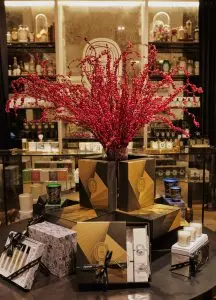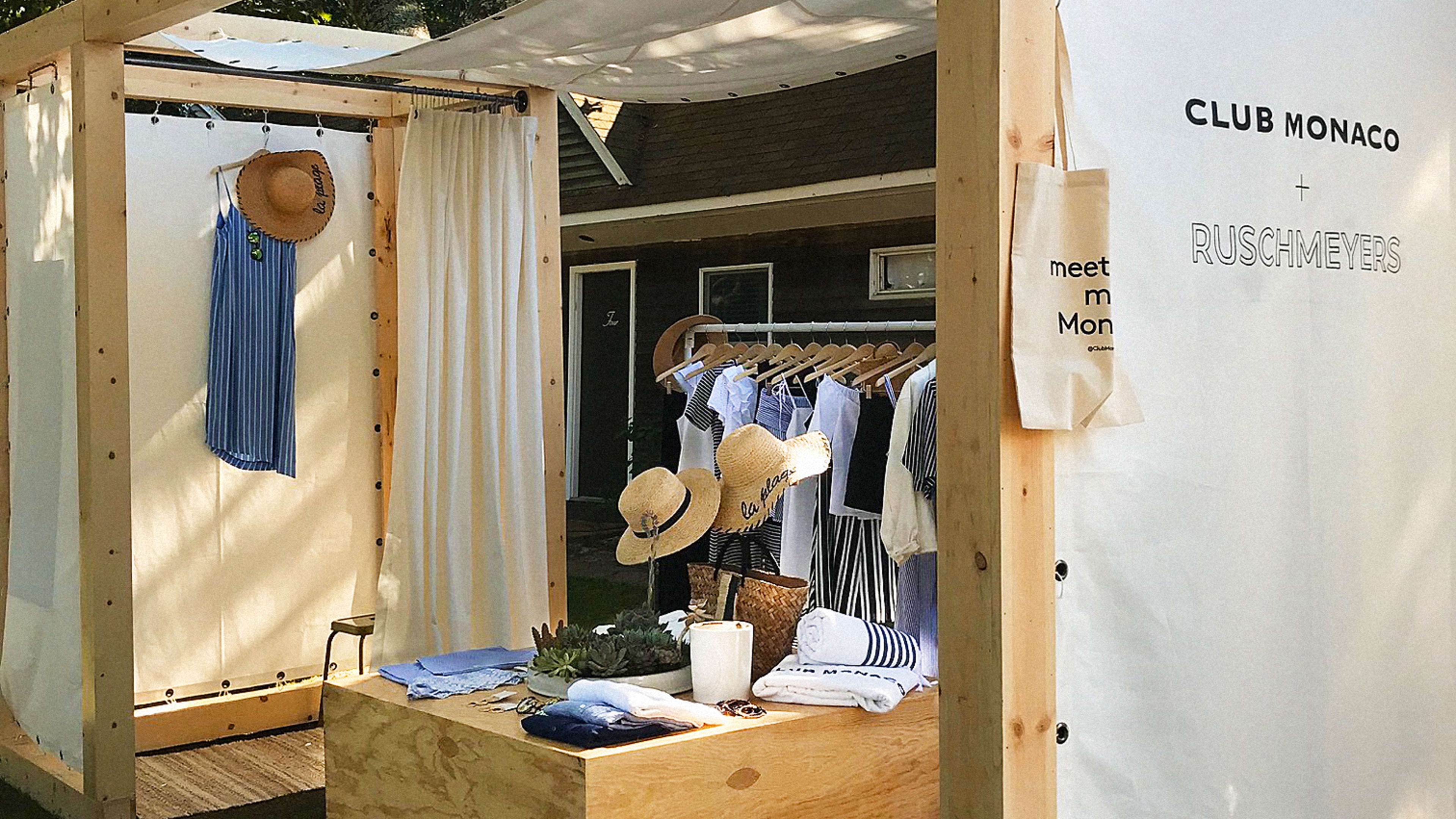Back in 1985, three Canadians opened a new store in downtown Toronto called Club Monaco selling fashion inspired by a lifestyle of glamorous global travel. But in case the clothes weren’t quite enough to entice customers, the store served coffee, too.
At the original Queen Street West location–which is still up and running today–there was a cafe, where shoppers could linger over a gourmet sandwich or iced latte. From time to time, Club Monaco would turn the street outside the store into a little outdoor market, complete with flower stalls and pastry vendors. Even back then, before the retail apocalypse hit North America, causing thousands of stores to shutter every year, Club Monaco’s founders–Joe Mimran, Saul Mimran, and Alfred Sung–knew that a good shopping experience was about more than just a transaction between merchant and buyer. It should be pleasurable and entertaining.
To figure out what this looks like in the 21st century, the 33-year-old brand is borrowing from the playbook of today’s startups, which have come up with creative ways to get customers into stores. Over the last three years, Francis Pierrel, Club Monaco’s CEO, has been tinkering with a little experiment: What if an established brand like Club Monaco remade itself in the image of a fledgling company?
“You have the new guys and you have the older guys, like us,” Pierrel says. “Not so long ago, the better retailer was the one who had as many stores as possible. But customers no longer treat stores like warehouses, where they go to pick up products in their size; they go to stores to hear a brand’s story and to be entertained.”

The Fate Of The Megabrands
Club Monaco has grown into an international mega-brand. It creates men and women’s clothes in the “affordable luxury” category, with jeans the cost around $200, button-down shirts that start at $80, and dresses that are between $150 to $300. Its network of 133 stores extend to far-reaching corners of the globe, from Sweden to Singapore to Saudi Arabia. In 1999, Club Monaco was quietly acquired by Ralph Lauren for $56 million, although it has remained independent both in terms of its brand identity and its leadership.
But these days, being a big retailer has challenges. Over the past few years, fashion corporations with large networks of brick-and-mortar locations have struggled financially, as consumers have chosen to shop online rather than in stores.
And Ralph Lauren itself has seen a 7% decrease in revenue last year and a 15% decrease in North America alone. While Ralph Lauren doesn’t break its financial report down on a brand by brand basis, Club Monaco was deemed to be underperforming as recently as two years ago. At the time, Ralph Lauren’s then-CEO, Stefan Larsson, backed out of two expensive Manhattan leases for Club Monaco at the very last minute because he believed they would aggravate the brand’s financial woes.
Related: The Decline Of Premium American Fashion Brands. What Happened, Ralph And Tommy?
The Ralph Lauren company is far from alone. Many of Club Monaco’s competitors, including J.Crew and Gap-owned Banana Republic, have also been on a downward spiral, which I have documented in my reporting.
Meanwhile, digitally native fashion startups like Everlane, Allbirds, and MM.Lafleur, have been thriving, thanks to clever retail strategies that involve both e-commerce and in-person shopping experiences. In addition to opening stores, these brands have played with the concept of pop-ups, creating temporary concept stores to introduce their products to new audiences, rather than investing in long-term property leases.

Stealing Tricks From Startups
In some ways, Pierrel’s strategy goes back to Club Monaco’s roots as a cafe-and-clothing boutique combo. In 2013, the brand converted part of its flagship Fifth Avenue location into a coffee shop that served trendy Toby’s Estate Coffee and a bookstore operated by The Strand. Both collaborations have been so successful that they have become ongoing partnerships at the store. This year, Pierrel has continued this strategy of partnering with other brands by launching pop-ups in key stores, including Boston, Southampton, Los Angeles, Toronto, and Montreal.

All summer long, Club Monaco has partnered with a diverse range of brands from Diptyque, the Parisian luxury candle brand, to tiny startups like The Buff, a customizable skincare brand. “With the pop-up, we thought we would find like-minded brands, whether they are very famous or just starting out in the world of business,” Pierrel says. “We could give them a stage in our own stores as a complement to our own products.”
In some ways, the pop-up approach is counterintuitive for a big brand, as Pierrel himself will admit. After all, Club Monaco must pay expensive real estate prices to be able to have a store on Fifth Avenue, and it is giving away some of this precious space to startups with tiny audiences. This is perhaps what deters many other large fashion labels from hosting pop-ups. But Pierrel believes that misses the point. “This is actually the new marketing,” Pierrel says. “Compelling your customers, surprising your customers on the moment’s notice. It is actually about driving traffic.”

To take it’s pop-up strategy a step further, the Pierrel’s team thought it might also be fun to pop into other spaces. That’s how the brand ended up in Ruschmeyer’s, a well-known Montauk hotel. Guests who stayed during the Fourth of July weekend received special Club Monaco perks, like cobranded totes and beach towels. “We have to find other ways to exist,” he says.
This strategy also appears to be inspired by other young brands. Luggage startup Away popped up at the Amastan Hotel in Paris during Fashion Week last year. Cosmetics startup Glossier popped up at a Rhea’s Cafe in San Francisco, whose pink exterior is almost identical to the brand’s millennial pink branding. For startups, popping up at trendy hotels and restaurants is a smart way for brands to tap into new audiences, but it also creates Instagrammable opportunities for guests. This seemed to work for Club Monaco as well, giving the social media reaction to the event.
Websites Are More Than Digital Catalogs
Of course, a pop-up strategy alone isn’t enough to keep a brand like Club Monaco thriving. Pierrel says that Club Monaco’s customers have migrated from brick-and-mortar stores to e-commerce, which has been growing by 20% over the last few years. So the brand has had to think about how to be more efficient with its stores. The brand used to have separate men’s and women’s stores, but it has now either closed these mono-gender stores or converted them into dual-gender stores. “This has increased the productivity of the stores,” Pierrel says, referring to comparable store sales. (Club Monaco declined to give specific figures.)
And Club Monaco is now working on a big project of transforming its website. Like many other legacy brands with a strong retail presence, Club Monaco’s website was in some ways an afterthought, or a digitized catalog of products. But for startups that are digitally native, the website is a much more meaningful experience, since it needs to convey the brand’s entire point of view to the customer. So Pierrel is leading an initiative to rebuild the brand’s website from the ground up. “When you’re a startup, you don’t have a store because you don’t have the money for that,” he says. “We’re going to treat our website exactly like that. The website needs to become more humanized, where actually we tell stories, we market, and we interact with our customers.”
But for Pierrel, these experiments with the website and the brick-and-mortar presence are not really an end in themselves. They’re part of a broader strategy of being more open to new ideas and willing to nimbly execute on them. None of this is easy with a company the size of Club Monaco, which makes tens of thousands of products a year. And it is even harder when it is part of a leviathan like Ralph Lauren.
Unlike the CEO of a startup, Pierrel must make a strong case for each new initiative, and his superiors are ultimately answerable to shareholders. He described his frustration at how it is sometimes much slower to pitch and implement a new retail idea at a company the size of Ralph Lauren compared with small, emerging companies. “We work for a big, big company,” he says. “You need to prove your idea, then prove it again to another person. Then one day, you walk down the high street and your great idea has been implemented by a new company and they get to take all the credit for it.”
But Pierrel is adamant that it’s worthwhile for big brands to adopt the nimble startup approach. “If it doesn’t hurt our business and has a chance of actually enhancing the experience for the customer, we go for it,” he says. “And then we analyze the results. But no matter what, we try it for two months.”
Recognize your brand’s excellence by applying to this year’s Brands That Matter Awards before the early-rate deadline, May 3.









